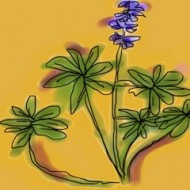The Dry Garden: In praise of Elmer Avenue
For all-around grooviness, a Sun Valley block that two years ago had no sidewalks, no street lights, no storm drains and no curbs should be next spring’s hot ticket on the home-tour circuit. Thanks to a newly completed makeover involving one federal bureau, one state agency, as many as six city agencies, three nonprofit groups and 24 homeowners, Elmer Avenue has become the Rolls-Royce of L.A.’s Green Street initiative.
Click here to keep reading in the Los Angeles Times about how the makeover of one block in the San Fernando Valley has resulted in a mass transition to drought tolerant gardens and the capture of 16 acre feet of storm water a year.…
The Dry Garden: Zausch and Di
Timing is everything when you’re a plant in a place with little water and lots of competition. Our native California fuchsia, Zauschneria californica, has patience. It remains sedate as the native sages and lilacs burst into spring blossom. Then, as the early bloomers slip into summer dormancy, this discreet gray-green shrub flowers, and flowers, and flowers, often straight through autumn.
Click here to keep reading about Zauschneria californica and its Uruguayan counterpart, Dicliptera suberecta, in The Dry Garden in the Los Angeles Times. Or, if you’re too mad to think about good flowering plants for hummingbirds because you really, really hate someone, buy them this book, reviewed today in the Los Angeles Times.…
The Dry Garden: Heirlooms by trial and error
A tomato left to rot in the garden last summer resulted this spring in my eating ripe homegrown heirloom tomatoes by Memorial Day instead of the normal harvest time around the Fourth of July. A fruit dropped in mulch sprouted in October rain, did nicely through winter storms and then, with some watering since May, the vines have been yielding what I’ve decided must be Cherokee Purple tomatoes for going on a month. In terms of flavor, they’re not Black Krims. No other tomato is. The word online is that Cherokee Purples rival Brandywines. That is true. In other words, they’re good enough that, with heirloom tomatoes of this quality costing $3 a pound in farmers markets, I thought I might be on to manna for readers. So I rang UC Davis’ C.M. Rick Tomato Genetics Resource Center to ask why every gardener in Southern California doesn’t plant tomatoes with …
The Dry Garden: Coyote mint
Paradise is at once so attainable and so far away.
This column was going to be about how the most immediate and affordable thing that Southern California homeowners could do to reduce our collective dependency on fossil fuel would be to rip out lawn. But events in the Gulf of Mexico are too crazy-making to be sure that it wouldn’t be the garden-writing equivalent of picking a fight at the dinner table. So this column is about coyote mint. Click here to keep reading The Dry Garden in the Los Angeles Times.…
The Dry Garden: Log love
Hackberry and coral tree wood gives loft to a bed with the hummingbird sage and an almost insect-like tendril of Artemisia californica (upper screen left). Photo copyright: Diane Cu / whiteonricecouple.com. Reprinted with permission.
In taking nature apart and putting it back together again in our gardens, we err toward the refined. This is the case with mulch. Nowhere is it written that it has to come chipped, much less in a bag from a store. In fact, there is much to be said for laying it down by the log.
Click here to keep reading today’s Dry Garden column on the beauty and benefit of deadwood in the garden. Or for full listings of dry garden events for June and July, click here.
Diane Cu’s photograph comes from this writer’s garden; on Cu’s first visit she was immediately struck by the texture and form of the deadwood and …
« go back — keep looking »

